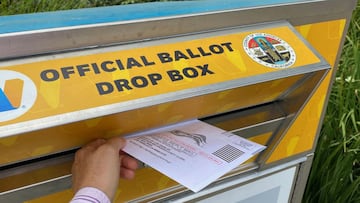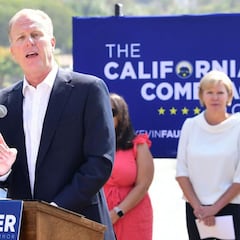What is a recall election?
California Gov. Gavin Newsom faces a challenge in the upcoming gubernatorial election, but what is a recall election and how will the outcome be decided?


The future of California Gov. Gavin Newsom is hanging in the balance as he prepares to contest what is only the second recall election in the state’s history. The official date of the recall election is 14 September but, with expanded voting options due to the pandemic, that date acts as a deadline by which voters must have returned their ballot.
But what is a recall election? And why have the state’s 22 million registered and active voters been given the opportunity to decide if a governor can remain in office for the remainder of his term?
How do recall elections work?
A recall election is a constitutional function which allows residents of a state to dismiss a serving governor, during his term, if voters deem it necessary. However it is considered an option of last resort and they are incredibly rare because the incumbent rarely loses.
For people voting by mail in the recall election, make sure to properly place your completed ballot in the return envelope. Watch this video to see why.
— Larry Elder (@larryelder) September 1, 2021
Learn more >> https://t.co/uyyrvTI6R9#RecallGavinNewsom #WeveGotAStateToSave pic.twitter.com/tMRQAMOgv2
The rules vary on a state-by-state basis but in California a recall petition must receive the signatures of enough registered voters to equal at least 12% of the turnout in the last election for governor. The petition must also include at least 1% of the previous turnout in each of the state’s five counties, and must do so within 160 days.
For Newsom’s recall, the petitioners had to find 1,495,709 valid signatures. By 8 June their effort had already amassed more than 1.7 million supporters. It became just the second of the 179 recall attempts to have made it to an election.
Who can run in a recall election?
Standing against the incumbent governor is a particularly daunting task in this huge state with nearly 40 million people and vast, lucrative media markets. However the requirements to enter the ballot are fairly inclusive: you must either pay a filing fee of around $4,000 or submit 7,000 signatures supporting your campaign.
The ballot itself poses two questions for voters: Should the governor be recalled? And if so, who should be the new governor?
Voting in the California recall election?
— Los Angeles Times (@latimes) September 3, 2021
Read about the 46 candidates on the ballot and how to make sure your vote is counted in our voter guide: https://t.co/IXTUc2rIf9
Related stories
The election is structured so that if at least 50% of respondents vote no to the first question, then the election is moot and the governor will remain in office. However if a majority want the governor removed than a count of the votes for each challenger in the second question will decide the next governor.
This system has been criticised because, with 46 candidates in the running to replace Newsom, it is possible that the incumbent could secure more votes than any other candidate but still be removed from office. If he was to poll 49% he would automatically be discounted and the most popular challenger would take his place as the governor of California, regardless of how they polled in comparison to Newsom.

